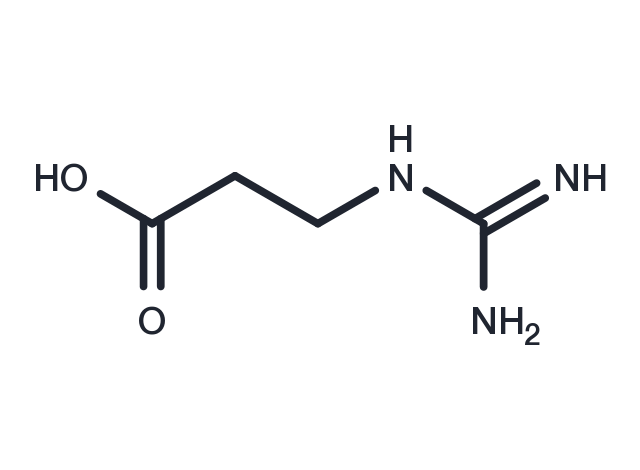Powder: -20°C for 3 years | In solvent: -80°C for 1 year


RGX-202 (β-GPA) is a creatine analog that alters skeletal muscle energy expenditure. It reduces cellular ATP, creatine, and phosphocreatine levels and stimulates AMP-activated protein kinase (AMPK), activating PPARγ coactivator 1α (PGC-1α).

| Pack Size | Availability | Price/USD | Quantity |
|---|---|---|---|
| 25 mg | In stock | $ 30.00 | |
| 50 mg | In stock | $ 39.00 | |
| 100 mg | In stock | $ 55.00 | |
| 200 mg | In stock | $ 80.00 | |
| 500 mg | In stock | $ 133.00 | |
| 1 g | In stock | $ 195.00 |


| Description | RGX-202 (β-GPA) is a creatine analog that alters skeletal muscle energy expenditure. It reduces cellular ATP, creatine, and phosphocreatine levels and stimulates AMP-activated protein kinase (AMPK), activating PPARγ coactivator 1α (PGC-1α). |
| In vitro | 3-Guanidinopropionic acid evokes a shift from glycolytic to oxidative metabolism, increased cellular glucose uptake, and increased fatigue tolerance[1] |
| In vivo | 3-Guanidinopropionic Acid(β-GPA) downregulated the expression of the β-oxidation genes.?Administration of β-GPA in mice for 3 weeks improved the animals' physical strength and endurance health, ie, increased their physical strength and endurance and alleviated anxiety.?β-GPA might be considered an adaptogene affecting both the muscle and brain metabolism in mammals[2]. |
| Animal Research | The following animal groups were used for the experiment: (1) mice that were not subjected to injections (n = 10)—this group was used only for physiological tests and were not killed after the experiment;?(2) saline-treated mice (n = 8)—the volume of injections was 200 μL;?and (3) β-GPA-treated mice (n = 8)—concentration of β-GPA was 1 mg/kg/day.?The volume of injections was 200 μL.Injections were performed 3 times a week for 3 weeks.?The mice's weight and the total amount of consumed food and water were measured daily.?Once a week, a string test was performed.?Measurements of the oxygen consumption rates of live animals and the open field test were performed after the course of injections.?After 3 weeks, the mice were killed;?brain dissection was performed to extract the cortex and the ventral midbrain (VMB) for quantitative real-time polymerase chain reaction (qRT-PCR) analysis[2]. |
| Synonyms | β-GPA, 3-Guanidinopropionic Acid |
| Molecular Weight | 131.13 |
| Formula | C4H9N3O2 |
| CAS No. | 353-09-3 |
Powder: -20°C for 3 years | In solvent: -80°C for 1 year
DMSO: Slightly soluble
You can also refer to dose conversion for different animals. More
bottom
Please see Inhibitor Handling Instructions for more frequently ask questions. Topics include: how to prepare stock solutions, how to store products, and cautions on cell-based assays & animal experiments, etc.
RGX-202 353-09-3 Chromatin/Epigenetic DNA Damage/DNA Repair Metabolism PI3K/Akt/mTOR signaling AMPK PPAR cancer apoptosis inhibit beta-GPA creatine import b-GPA β-GPA Inhibitor RGX 202 oral 3-Guanidinopropionic Acid mice Endogenous Metabolite RGX202 inhibitor
